Occupational Environment Monitoring at Television Manufacturing Factory
99,000 ₫
Note: The above price is calculated per sample and may vary depending on the area of the environment to be monitored and market fluctuations. For more accurate pricing support, please refer to the price list or contact our consulting staff directly.
Monitoring the environment of a television production factory is a session for collecting, analyzing, and evaluating workplace factors that may be harmful to workers’ health.
Table of Contents
Toggle1. Overview of Television Manufacturing Factory
a. What is a television manufacturing factory?
Manufacturing factory for televisions is a specialized production facility designed to manufacture televisions and related devices. In this factory, the television production process is carried out from design, assembly, and testing to packaging and transportation.
The television manufacturing factory may have multiple departments and work areas such as the design room, research and development room, component production room, assembly room, quality control room, and packaging room.
During television production, the factory uses high-tech equipment and machinery to ensure product quality and performance. New technologies such as OLED screens, QLED, advanced imaging technology, and surround sound are also integrated and produced in this factory.
The goal of the television manufacturing factory is to produce high-quality television products that meet consumer demands and requirements in the home electronics market.

b. Production stages in a television manufacturing factory
The production stages in a television manufacturing factory can be quite diverse and complex, depending on the scale and production methods of each factory. Below is an outline of the main stages in the television production process:
- Design and development: The process starts with research, design, and development of new television models. Designers and engineers generate ideas, create prototypes, and test them to develop new features, styles, and technologies.
- Purchasing components and materials: The factory procures the necessary components and materials to manufacture televisions. These may include screens, electronic components, motherboards, processors, speakers, remote controls, and materials such as plastic, metal, and other parts.
- Component processing and assembly: Components are processed, manufactured, and assembled step by step. This includes assembling screens, motherboards, audio systems, frame structures, control buttons, cable connections, and other parts.
- Firmware and software installation: After assembling the basic components, the television requires firmware and software installation to function. This includes installing the operating system, applications, user interface, and other special features.
- Quality control: All televisions are tested for quality to ensure proper operation, no defects, and compliance with quality standards. Testing may include checking image, sound, connectivity, remote control, and other features.
- Packaging and transportation: After completion and quality testing, televisions are packaged according to specific procedures and standards. Packaging includes boxing, surface protection, providing accessories and manuals. The products are then transported to distribution locations or retail stores.

c. Machinery used in television manufacturing factories
In television manufacturing factories, various high-tech machines and equipment are used to carry out production stages. Some common machinery that may be used in television production includes:
- Metal cutting and processing machines: Machines used to cut and process metal parts such as frames, stands, bezels, and other television components.
- Soldering and component mounting machines: Used to solder and mount components like motherboards, sockets, connectors, and other electronic parts onto the motherboard and other assemblies.
- Plastic processing machines: Used to manufacture plastic parts such as television casings, control buttons, back covers, and other components.
- Screen pressing machines: Used to press LCD or OLED screens into the television frame.
- Firmware and software loading machines: Used to install firmware and software onto motherboards and other electronic components during television assembly.
- Testing and calibration machines: Used to check quality, performance, and functionality of components and finished television products.
- Control button and remote assembly machines: Used to install control buttons and assemble remote controls.
- Packaging machines: Used to pack and protect televisions during final packaging before transportation.

d. Occupational diseases that may occur in television manufacturing workers
In television manufacturing factories, workers may be exposed to some occupational diseases related to the working environment and production process. Some common occupational diseases in the television manufacturing industry include:
- Respiratory diseases: Workers may be exposed to dust and chemicals from processing and painting processes, leading to respiratory problems such as asthma, bronchitis, pneumonia, and other respiratory issues.
- Vision problems: Tasks involving inspecting and assembling small components may cause eye strain and fatigue, resulting in dry eyes, conjunctivitis, and myopia.
- Hearing problems: Working in noisy environments may cause hearing damage, including hearing loss and noise-related ear health issues.
- Hand and neck disorders: Assembly and handling of small components may cause stress and injuries to hands and neck, including cervical spine degeneration, muscle inflammation, and other related issues.
- Posture and spine problems: Workers may need to work in uncomfortable or awkward positions during assembly and testing, leading to back pain and spine problems.
To prevent and reduce occupational diseases, television manufacturing factories need to implement safety measures and ensure a healthy and safe working environment. This includes providing protective equipment, safety training, regular inspections, and compliance with occupational safety and environmental standards.

e. Popular television types in the market
There are many popular television types in the market today, including:
- LED TV: Uses Light Emitting Diode (LED) for screen backlighting. It is popular and cost-effective. LED TVs come in various sizes and resolutions, from Full HD to 4K and 8K.
- OLED TV: Organic Light Emitting Diode (OLED) TV uses organic compounds to generate light. OLED TVs are thinner, provide sharper colors, higher contrast, and wider viewing angles compared to LED TVs.
- QLED TV: Quantum Dot LED (QLED) TV uses quantum dots to produce precise colors and high contrast. QLED TVs are bright, colorful, and support HDR (High Dynamic Range).
- Plasma TV: Uses plasma cells to generate light. Although less popular today, Plasma TVs are praised for contrast and color reproduction.
- Smart TV: Can connect to the internet and access online apps and services such as Netflix, YouTube, Spotify, and more, allowing users to enjoy multimedia entertainment.
- Android TV: Runs on Google’s Android OS, enabling access to Google Play Store for apps, games, and content.
- Curved TV: Has a curved screen for smoother images and wider viewing angles, providing a more immersive viewing experience.
- 3D TV: Allows viewing of 3D content for a more realistic experience. Although less common today, some TVs still support 3D mode.

2. Overview of Occupational Environment Monitoring Services
a. What is occupational environment monitoring at television manufacturing factories?
Occupational environment monitoring (or workplace environment measurement) at television manufacturing factories involves collecting, evaluating, and analyzing measured indicators of workplace environmental factors in the factory to implement timely measures, minimize environmental impacts on worker health, and prevent occupational diseases. Workplace environment monitoring is mandatory for television manufacturing factories.
Occupational environment monitoring is crucial for protecting, maintaining, and enhancing workers’ health because workers are the main resource and directly generate profit for the enterprise. Workers frequently exposed to occupational hazards above permissible limits are at risk of health issues and occupational diseases.
REGISTER FOR OCCUPATIONAL ENVIRONMENT MONITORING SERVICE
b. Nam Viet’s occupational environment monitoring program
Nam Viet’s occupational environment monitoring program is developed by monitoring engineers in occupational safety and environmental protection. With the goal of ensuring workers’ health and safety, the program uses modern measurement methods to monitor air quality, water, microclimate, physical factors, dust, and other workplace environmental factors. This program is crucial for maintaining a safe working environment and protecting worker health.
Additionally, Nam Viet’s program plays an important role in researching and developing new solutions to improve workplace environmental quality. With the dedication and professionalism of its monitoring experts, Nam Viet’s exclusive monitoring program has become a breakthrough in occupational safety and environmental management in Vietnam.

c. Standardization in occupational environment measurement procedures
Standardization in Nam Viet’s workplace measurement procedures is crucial to ensure measurement accuracy and reliability. The program applies recognized standards and standardized procedures from Ho Chi Minh City Department of Health, ensuring that collected data is highly reliable for evaluating the work environment and making decisions to improve workplace conditions and protect worker health.
These standardized procedures also ensure that measurements are conducted by highly qualified monitoring specialists with years of experience, allowing managers and experts to trust the results from An Toan Nam Viet and make accurate decisions to safeguard workers and the environment.
By applying standardization in occupational environment measurement, Nam Viet demonstrates its commitment to providing a safe working environment and protecting worker health while contributing to the advancement of occupational safety and environmental management in Vietnam.
d. Occupational environment monitoring report at television manufacturing factories
Occupational environment monitoring results are prepared according to Form No. 04 Appendix III issued with Decree 44/2016/ND-CP and made in two copies: one copy is sent to the contracting workplace, and one copy is retained at the organization performing occupational environment monitoring.
The retention period of occupational environment monitoring results is indefinite according to legal regulations.

e. Frequency of occupational environment monitoring as per law
According to Clause 2 of Article 18 of the Law on Occupational Safety and Hygiene 84/2015/QH13, employers must organize workplace environment monitoring to assess harmful factors at least once a year.
f. Deadline for submitting occupational environment monitoring reports as per law
The deadline for submitting reports is before December 31 each year. Enterprises operating manufacturing facilities must submit occupational environment monitoring reports to the Department of Health in the locality where the main office and employees are located.
When there are changes in technology, production processes, or renovations/upgrades that may introduce new harmful factors, manufacturing enterprises must update occupational hygiene records concerning harmful factors requiring workplace monitoring.
g. Penalties for violations of occupational environment monitoring by employers
According to Article 27 of Decree No. 12/2022/ND-CP dated January 17, 2022, on administrative penalties in labor, social insurance, and Vietnamese workers working abroad under contracts:
- Clause 2: Fines from VND 2,000,000 – 5,000,000 for employers who fail to publicly disclose monitoring results and hazard assessments to employees at the monitored workplace immediately after results are obtained.
- Clause 3: Fines from VND 20,000,000 – 40,000,000 for employers who fail to conduct occupational environment monitoring to control harm to worker health as required by law.
- Clause 4: Fines from VND 40,000,000 – 60,000,000 for employers who collude with monitoring organizations to commit fraud in occupational environment monitoring activities but not to the level of criminal liability.
3. Harmful Environmental Factors for Workers in Television Manufacturing Factories
In the working environment of television manufacturing factories, several harmful environmental factors may affect workers’ health. Here are some potential harmful factors:
- Dust: The television production process can generate dust from metal processing, plastic molding, and assembly operations. Dust may contain heavy metal compounds such as lead, cadmium, mercury, and other chemicals, which can harm the respiratory and nervous systems.
- Chemicals: Painting, maintenance, and processing activities in television factories may involve chemicals such as solvents, dyes, and cleaning agents. Exposure to these chemicals can irritate the skin, eyes, and respiratory system, and may cause serious health problems if not properly managed.
- Noise: The production process may generate noise from machinery, equipment, and processing activities. Noise can damage hearing, cause stress, negatively impact health, and increase the risk of ear-related problems.
- Light: High-tech machinery and equipment used in television production may produce intense lighting, especially blue light and ultraviolet light. Prolonged exposure can cause eye strain, fatigue, and affect vision.
- Temperature and humidity: The working environment in television factories may have unstable temperature and humidity levels. Unsuitable conditions can make work difficult and affect workers’ health and comfort.
- Electromagnetic exposure: Machinery and electronic devices used in production may generate electromagnetic fields. Prolonged exposure can cause stress and affect health, especially for individuals with preexisting conditions such as heart disease or those with implanted electronic devices.
REGISTER FOR OCCUPATIONAL ENVIRONMENT MONITORING SERVICE
4. Measures to Improve the Working Environment in Television Manufacturing Factories
To improve the working environment in television factories and protect workers’ health, the following measures can be implemented:
- Manage dust and chemicals: Ensure safe and effective work procedures to control dust and chemicals during production. This includes using dust extraction systems, personal protective equipment such as masks and gloves, and complying with regulations on chemical waste management.
- Ensure electrical safety: Inspect and maintain electronic equipment and electrical systems to prevent unintended electromagnetic exposure. This includes using anti-shock devices, periodic inspection and maintenance of electrical systems, and training workers on electrical safety.
- Control noise: Implement measures to reduce noise in the factory, including using noise-reducing equipment, soundproofing, insulation, noise barriers, and providing hearing protection for workers.
- Manage lighting: Ensure adequate natural light and appropriate artificial lighting in the factory. This may include using efficient lighting and adjusting brightness to reduce eye strain and fatigue.
- Adjust temperature and humidity: Maintain stable and comfortable temperature and humidity conditions for workers. Use air conditioning and manage ventilation to ensure an optimal working environment.
- Training and education: Provide workers with training and education on workplace safety and health protection. This includes instructions on using protective equipment, following safety procedures, and complying with workplace regulations.
- Periodically conduct occupational environment monitoring in factories to collect and analyze harmful factors, then implement adjustments to reduce hazards and prevent occupational diseases.
5. Benefits of Regular Television Factory Environmental Monitoring
An Toan Nam Viet provides enterprises with excellent benefits when using occupational environment monitoring services in accordance with Decree 44/2016/ND – CP on managing and controlling harmful factors in the working environment affecting workers.
- Enterprises can proactively control harmful factors in workshops or factories.
- Receive advice and recommendations to minimize hazards and improve workplace quality.
- Indirectly protect human resources, the key factor in business development.
- Reduce the impact of occupational diseases on health, thereby lowering future treatment costs.
- Improved worker health ensures product quality and maintains production output.
- Ensure compliance with labor safety laws and avoid legal risks.
- Enhance credibility and professionalism, elevating the enterprise brand.
Nam Viet’s environmental monitoring service is a solution to reduce occupational disease risks, contributing to a clean and high-quality working environment.

6. Nationwide Occupational Environment Monitoring Center
Nam Viet Occupational Environment Monitoring Center is a professional unit specializing in monitoring and measuring occupational environment quality across all provinces in Viet Nam. With a team of experienced monitoring specialists, the center uses modern measuring equipment to ensure accuracy and reliability.
In addition to monitoring services, the center assists clients in planning, handling, and tracking occupational environment issues. With the motto “customer-centric,” the center prioritizes client satisfaction, meets all client needs, and commits to providing the best solutions for enterprises.
REGISTER FOR OCCUPATIONAL ENVIRONMENT MONITORING SERVICE
With investment in technology, equipment, and personnel, Nam Viet’s monitoring center has become one of the most reputable units in occupational environment monitoring in Ho Chi Minh City, with the following objectives:
- We always value our brand reputation and the quality of our services.
- We provide clients with the best and most suitable solutions.
- With a team of experienced Masters and Engineers, committed to protecting the environment and benefiting enterprises.
- Clients using Nam Viet Environmental Monitoring receive professional service from experts in the field, along with the best cost advantages.
The occupational environment monitoring process at Nam Viet includes the following basic steps:
- Before conducting monitoring, we ensure all equipment is calibrated and meets legal requirements.
- Follow the occupational environment monitoring procedures as committed to the Department of Health.
- Accurately report monitoring results to employers.
- If monitoring results indicate unsafe conditions for workers, Nam Viet will assist in implementing corrective measures, and the enterprise will:
- Implement measures to improve working conditions and minimize harmful factor impacts, preventing occupational diseases.
- Organize health check-ups to detect occupational and related diseases early for workers in unsafe environments.
- Provide compensation in kind for workers according to labor law regulations.

7. Occupational Environment Monitoring Price List
To help enterprises conduct professional and effective occupational environment monitoring, Nam Viet provides clients with a detailed price list for monitoring services that is high-quality and reasonably priced.
- Our price list provides detailed information about monitoring service costs, including transportation, measurement, analysis, and report preparation. Clients can trust the accuracy and reliability of our monitoring reports.
- We commit to offering competitive and reasonable prices while providing prompt and professional consultation for any monitoring service inquiries.
- With Nam Viet’s price list, clients can easily select service packages that suit their needs, ensuring maximum satisfaction with professional service quality.
No comments yet

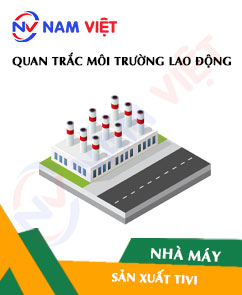
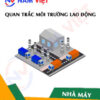
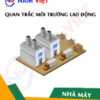


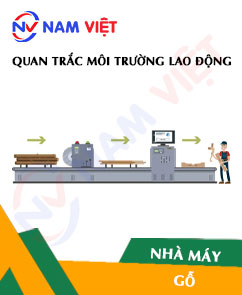

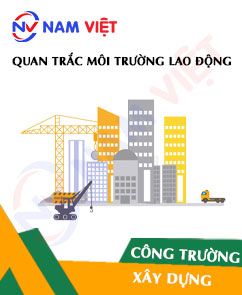



Review Occupational Environment Monitoring at Television Manufacturing Factory
There are no reviews yet.